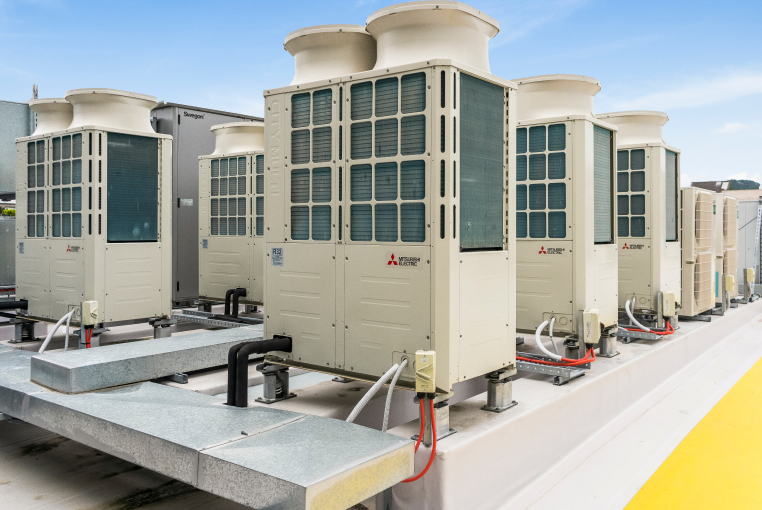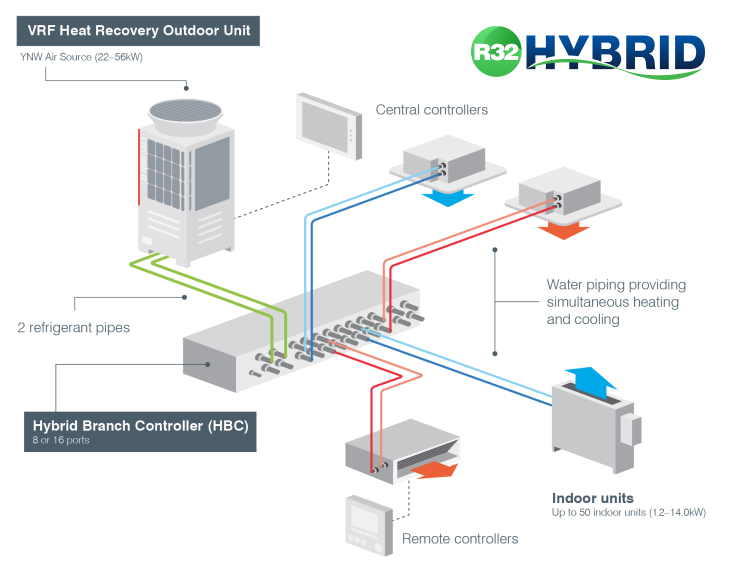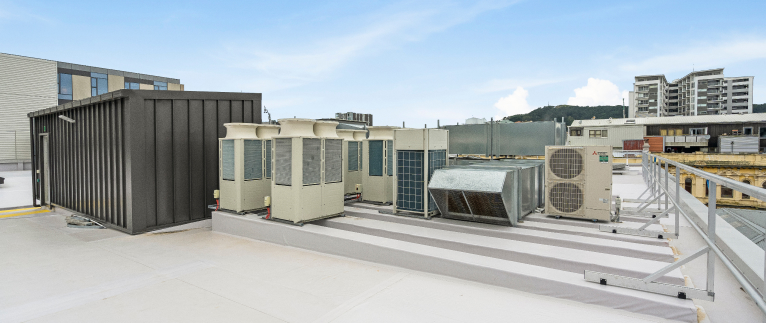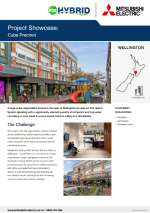Cuba Precinct, Wellington
A large scale regeneration project in the heart of Wellington city uses an R32 Hybrid VRF System operating with a significantly reduced quantity of refrigerant and only water circulating in work areas to ensure tenant comfort, safety and affordability.
The Challenge
This major inner city regeneration project required an air conditioning system able to provide a safe, comfortable working environment with a small carbon footprint while reducing operational and maintenance costs.
Situated in what is often termed ‘the true heart of Wellington’, Cuba Precinct is the result of a large regeneration project designed to embody the character of Cuba Street and its environs while providing space for ground floor retail businesses with office and apartment accommodation above. It involved preserving and injecting life into several historic buildings as well as raising new structures above those buildings.
Mitsubishi Electric’s Future-Proofed Sustainable Solution
In the latter part of 2020, the Greater Wellington Regional Council moved into the second and third floors of the newly created open plan office space – one of Wellington’s largest with an area of 6000 square metres.
Designed to have a low carbon footprint and exceed the current New Building Standard, the refurbishment of the historic buildings was completed with these guiding principles in mind. Therefore, the Mitsubishi Electric R32 Hybrid Variable Refrigerant Flow (HVRF) Air Conditioning System was a logical choice for the large open plan office space.
This was due to its superior safety features and occupier comfort levels as well as lower operating and maintenance costs when compared to traditional systems using R410A refrigerant.
The R32 HVRF System delivers a world first with simultaneous heating and cooling. Heat is recovered and redistributed, negating the need for a separate heating system. It uses a unique 2-pipe configuration - a reduced number of pipes which also reduces the installation cost and time.

Water is at the Heart of the System
A significant safety feature is the use of water throughout the pipework in occupied spaces. This means that refrigerant (R32) is only used in the system between the outdoor condensers and the Hybrid Branch Controllers (HBCs) – well away from any occupied spaces. This removes the need for expensive leak detection equipment in occupied spaces – resulting in reduced maintenance costs as there is no requirement for annual leak detection checks.
Hybrid Branch Controllers are the heart of the system. They link outdoor units to indoor units and are responsible for heat exchange between refrigerant-controlled outdoor units and water-based indoor circuits to indoor units. Water is circulated to indoor units by energy efficient pumps.
A simplified HVRF System diagram is shown below.

Unique 2-Pipe Architecture
Multi-layer composite plastic piping can be used to transport water throughout occupied spaces instead of the traditional soldered copper piping used to transport refrigerant. This feature combined with the unique 2-Pipe Heat Recovery System – rather than a conventional 4-pipe chiller system – means less piping is installed and none of the extra controls associated with a 4-pipe system are required, amounting to significant installation cost savings.
Modular and Flexible in Design
The modular design and small footprint of the HVRF System along with its flexible duct layout allows airflow patterns to be arranged to suit the application, letting building owners manage a phased installation – a plus when it comes to installation budgets and their inevitable variances.
Efficient Heating and Cooling at the Same Time
Outdoor units all have simultaneous heating and cooling and heat recovery. Indoor units are concealed within the ceiling space making for unobtrusive air conditioning while preserving the aesthetic of the working space and overall appearance of the room. Quiet operation is another feature of these units.

Jason Mann Photography
Year-Round Occupant Comfort
Low noise levels (due to the use of water instead of refrigerant in the terminal fan coils among other noise-reducing features), more stable milder off-coil temperatures, the removal of draught potential from office spaces, faster defrosts, no critical refrigeration concerns and less risk to the environment and occupants all contribute to a system that provides comfort with simplified maintenance and a significant cut in long-term energy costs.
Using the system’s flexible master and individual remote controls enables efficient and economic management of airflows, heating and air conditioning levels throughout the building.
As well as a master control, individual room units have remote controls of their own.

Jason Mann Photography
The Logical, Future-Proofed Solution
The cost of R410A refrigerant continues to rise rapidly as a deterrent to its use in air conditioning systems due to its high GWP (Global Warming Potential). Mitsubishi Electric’s R32 Hybrid VRF System leverages the low GWP of R32 refrigerant (about one third that of conventional R410A refrigerant), lower refrigerant costs, a small carbon footprint and reduced running costs to provide an efficient system with built-in future proofing able to provide high comfort levels while complying with environmental legislation – it’s the logical selection.

R32 Hybrid VRF Key Features:
- Simultaneous heating and cooling
- Utilises environmentally-friendly R32 refrigerant
- 2-Pipe Heat Recovery System requires less material and equipment
- Water, rather than refrigerant is at the heart of the indoor units
- Reduced maintenance costs
- Minimises the need for leak detection equipment
- Flexible design and modularity allows for a manageable, phased installation
- Quiet operation
- High sensible cooling and stable room temperatures
- Increased energy savings
Equipment Breakdown
HVRF SYSTEMS
R32 Outdoor Units
1 x PURY-M250YNW-A1-BS Heat Recovery Unit
4 x PURY-M350YNW-A1-BS Heat Recovery Units
2 x PURY-M450YNW-A1-BS Heat Recovery Units
4 x PURY-M500YNW-A1-BS Heat Recovery Units
Branch Controllers
17 x CMB-WM108V-AA Hybrid Branch Controllers
Indoor Units
2 x PEFY-WP32VMA-E Medium Static Ducted Units
1 x PEFY-WP40VMA-E Medium Static Ducted Unit
1 x PEFY-WP50VMA-E Medium Static Ducted Unit
1 x PEFY-WP63VMA-E Medium Static Ducted Unit
6 x PEFY-WP71VMA-E Medium Static Ducted Units
10 x PEFY-WP80VMA-E Medium Static Ducted Units
3 x PEFY-WP100VMA-E Medium Static Ducted Units
15 x PEFY-WP125VMA-E Medium Static Ducted Units
4 x PLFY-WP20VFM-E Compact Cassette Units
7 x PLFY-WP25VFM-E Compact Cassette Units
8 x PLFY-WP32VFM-E Compact Cassette Units
1 x PLFY-WP32VBM-E Cassette Unit
2 x PLFY-WP40VBM-E Cassette Units
2 x PKFY-WL20VLM-E High Wall Units
2 x PKFY-WL25VLM-E High Wall Units
Controllers
1 x AE-200E Touch Screen Centralised Controller with BACnet License
1 x EW-50 Expansion Module
33 x PAR-U02MEDA-E Local Hardwired Controllers
Publications
 City Multi New Zealand Showcase - Edition 2.pdf (10,526 KB),
City Multi New Zealand Showcase - Edition 2.pdf (10,526 KB),
Created: Monday 8th of September 2014 City Multi New Zealand Showcase - Edition 1.pdf (7,386 KB),
City Multi New Zealand Showcase - Edition 1.pdf (7,386 KB),
Created: Tuesday 11th of June 2013 City Multi World Wide Case Studies.pdf (3,184 KB),
City Multi World Wide Case Studies.pdf (3,184 KB),
Created: Wednesday 23rd of April 2008
Published: Thursday, 1 July 2021



